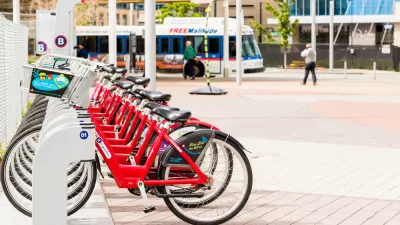California, the largest state by population in the United States, is responsible for 33% fewer carbon emissions per capita than any other state, according to a new study published in the Proceedings of the National Academy of Sciences.

The Proceedings of the National Academy of Sciences journal published "The carbon footprint of household energy use in the United States," a peer-reviewed study of about 93 million homes which shows that 20% of greenhouse gas emissions in the United States can be attributed to residential energy use. The study also found California households to be a step ahead of those in other states in limiting its carbon footprint, producing 33% fewer carbon emissions, reports Evan Webeck. "San Francisco’s household emissions were nearly three times lower than the national average — 1.03 tons of carbon dioxide per capita vs. 2.83 for the U.S. — and lower than any other major city included in the research paper. In Los Angeles, the average household contributed 2.28 tons of carbon dioxide for the year, compared to 3.64 in Oklahoma City, 3.11 in Denver and 2.69 in Boston," writes Webeck. The study was conducted to assess which states and communities needed to make the most dramatic change to meet goals set by the Paris Climate Agreement for the years 2025 and 2050.
A few key indicators accurately predicted which states have the most significant carbon footprints. The vast majority of the lowest carbon-emitting states were in the west while all of the greatest carbon carbon-emitting states were in the south and central United States. Another key indicator: income. Households in U.S. zip codes with the highest incomes "contributed 25% more carbon dioxide than households in low-income neighborhoods," Webeck says. Webeck adds that density, usually associated with decreased carbon dioxide emissions was not correlated with decreased carbon emissions to the same extent as income correlation.
FULL STORY: California way ahead in game of life and death: carbon emissions

Planetizen Federal Action Tracker
A weekly monitor of how Trump’s orders and actions are impacting planners and planning in America.

Maui's Vacation Rental Debate Turns Ugly
Verbal attacks, misinformation campaigns and fistfights plague a high-stakes debate to convert thousands of vacation rentals into long-term housing.

San Francisco Suspends Traffic Calming Amidst Record Deaths
Citing “a challenging fiscal landscape,” the city will cease the program on the heels of 42 traffic deaths, including 24 pedestrians.

Amtrak Rolls Out New Orleans to Alabama “Mardi Gras” Train
The new service will operate morning and evening departures between Mobile and New Orleans.

The Subversive Car-Free Guide to Trump's Great American Road Trip
Car-free ways to access Chicagoland’s best tourist attractions.

San Antonio and Austin are Fusing Into one Massive Megaregion
The region spanning the two central Texas cities is growing fast, posing challenges for local infrastructure and water supplies.
Urban Design for Planners 1: Software Tools
This six-course series explores essential urban design concepts using open source software and equips planners with the tools they need to participate fully in the urban design process.
Planning for Universal Design
Learn the tools for implementing Universal Design in planning regulations.
Heyer Gruel & Associates PA
JM Goldson LLC
Custer County Colorado
City of Camden Redevelopment Agency
City of Astoria
Transportation Research & Education Center (TREC) at Portland State University
Jefferson Parish Government
Camden Redevelopment Agency
City of Claremont





























